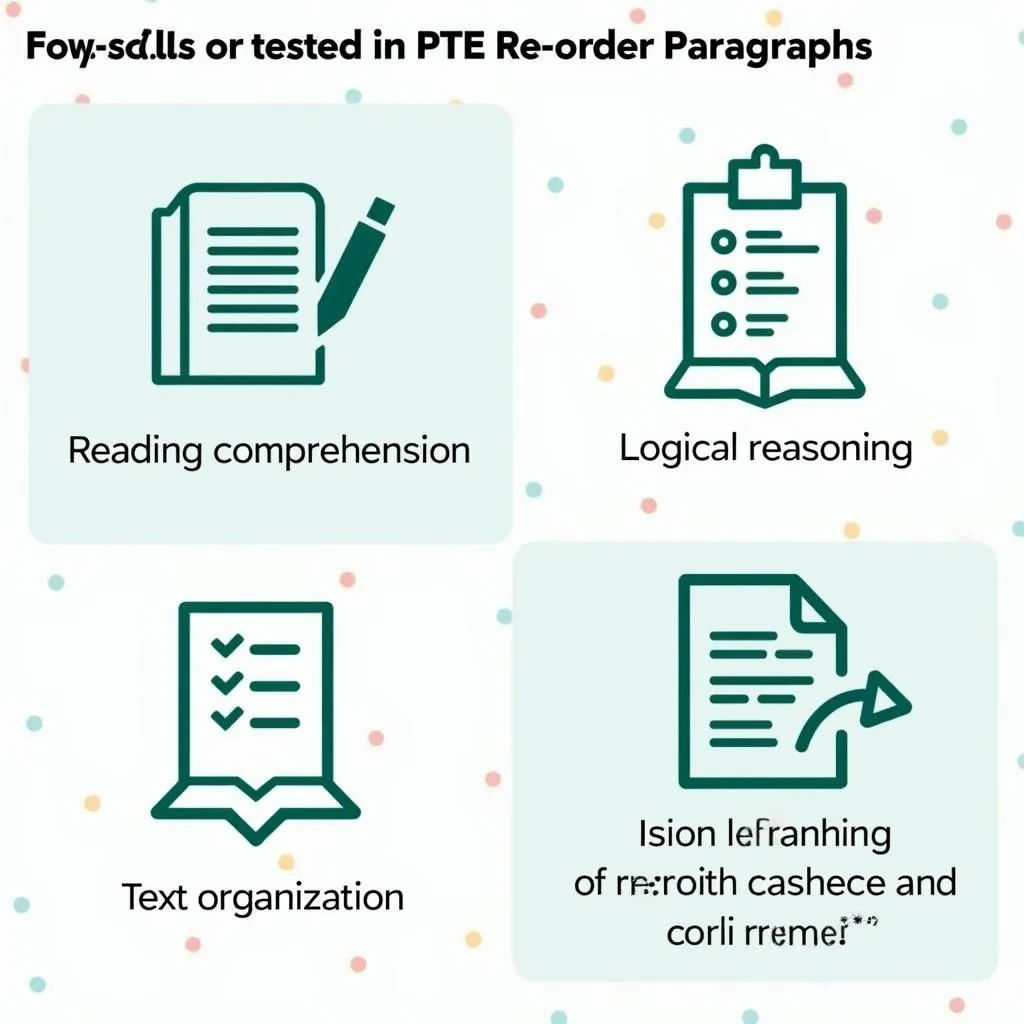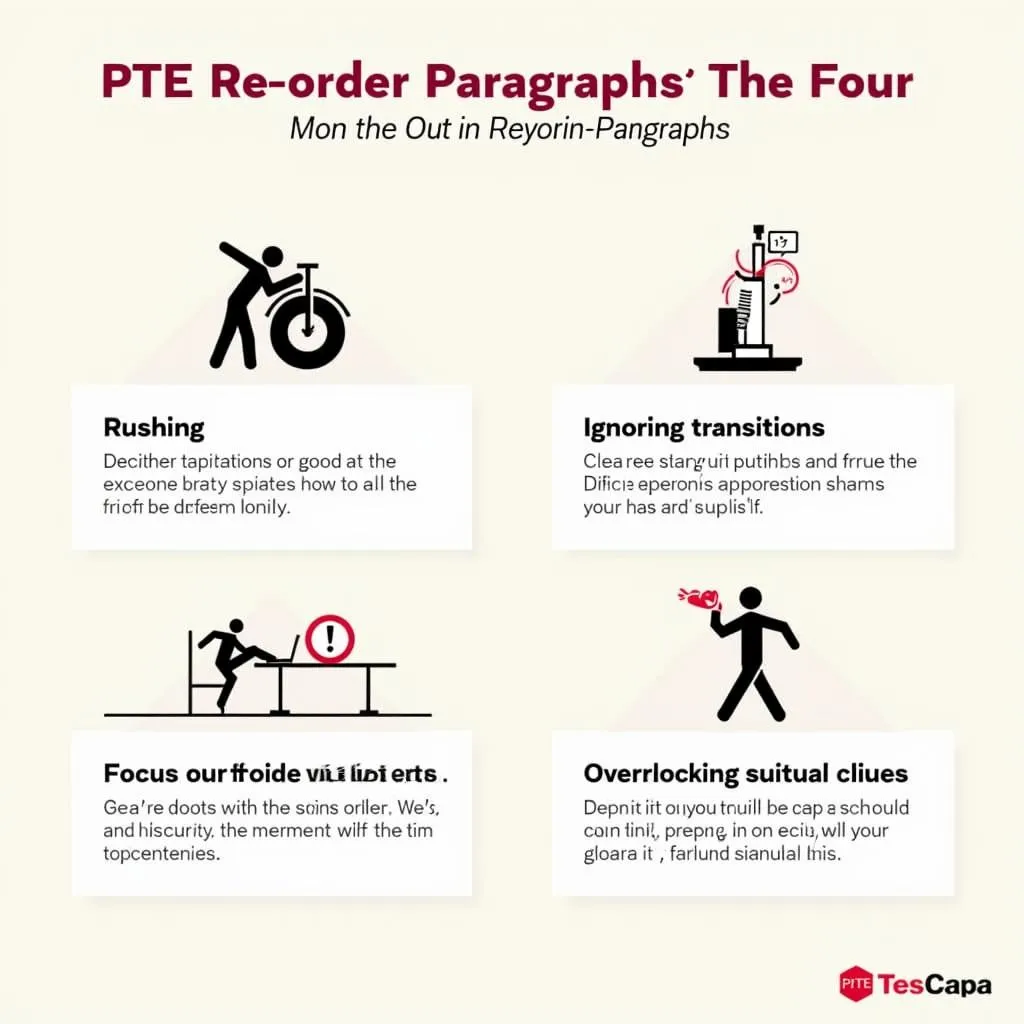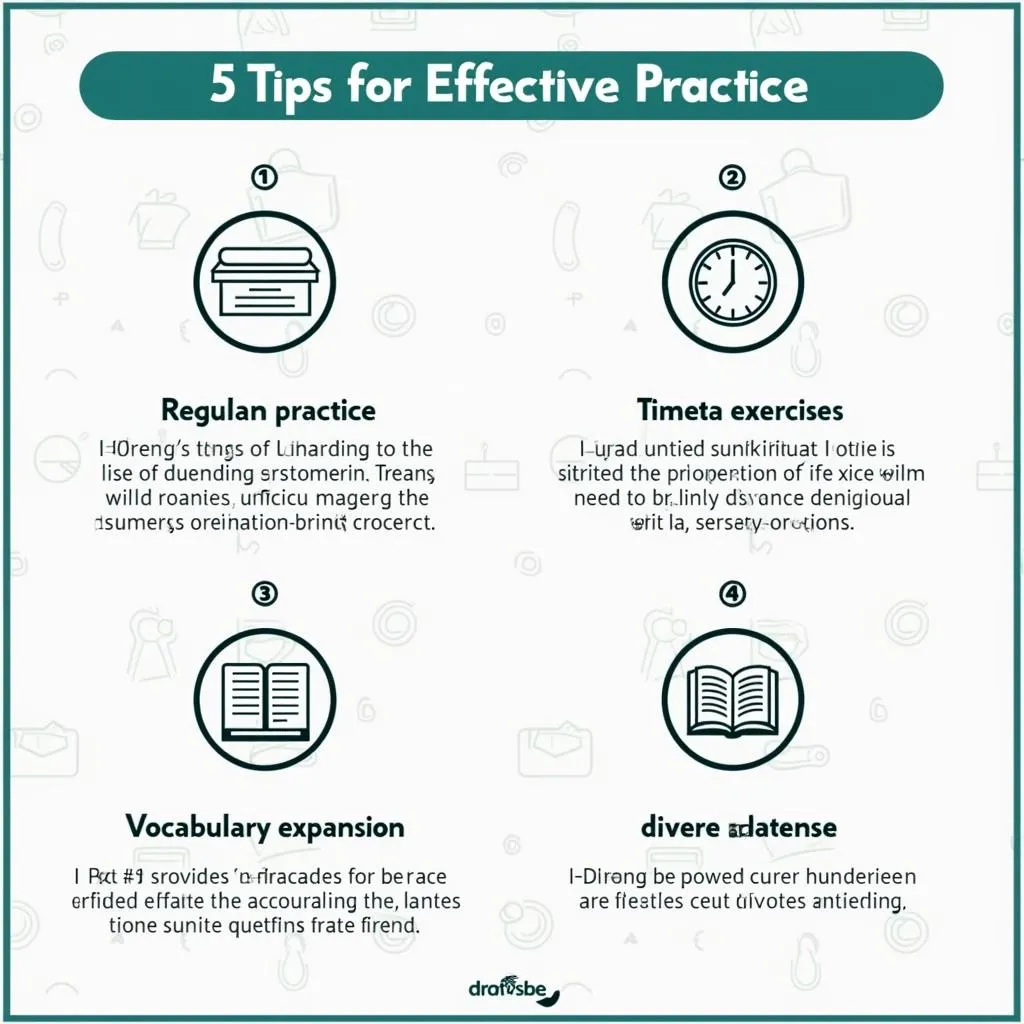Are you struggling with the PTE Re-order Paragraphs task? You’re not alone. This challenging section of the PTE Academic test often leaves test-takers feeling overwhelmed. But fear not! In this comprehensive guide, we’ll explore expert strategies and provide valuable practice exercises to help you ace this critical component of the exam.
Understanding the PTE Re-order Paragraphs Task
Before diving into the practice exercises, it’s essential to grasp the fundamentals of this task. The PTE Re-order Paragraphs section assesses your ability to understand the logical flow and coherence of a text. You’ll be presented with 4-5 jumbled sentences and must arrange them in the correct order to form a cohesive paragraph.
Key Skills Tested
- Reading comprehension
- Logical reasoning
- Text organization
- Understanding of cohesion and coherence
 Key skills tested in PTE Re-order Paragraphs
Key skills tested in PTE Re-order Paragraphs
Expert Strategies for PTE Re-order Paragraphs
To excel in this task, you need a solid strategy. Here are some expert tips to help you tackle PTE Re-order Paragraphs with confidence:
-
Identify the topic sentence: Look for the sentence that introduces the main idea of the paragraph. This is often (but not always) the first sentence.
-
Look for connecting words: Pay attention to transitional phrases, pronouns, and chronological markers that link sentences together.
-
Focus on logical progression: Understand how ideas develop from one sentence to the next. Does the information flow naturally?
-
Eliminate obvious choices: If you’re certain about the position of some sentences, focus on arranging the remaining ones.
-
Read the paragraph aloud: Once you’ve arranged the sentences, read them in order to check if they make sense as a cohesive whole.
How to practice reading speed for PTE can significantly improve your performance in this task, as it allows you to quickly process information and make connections between sentences.
Common Pitfalls to Avoid
While practicing, be aware of these common mistakes:
- Rushing through the task without careful reading
- Ignoring transitional phrases and connecting words
- Focusing solely on individual sentences instead of the overall context
- Overlooking subtle clues in sentence structure and vocabulary
By avoiding these pitfalls, you’ll be better equipped to tackle even the most challenging Re-order Paragraphs questions.
 Common pitfalls in PTE Re-order Paragraphs
Common pitfalls in PTE Re-order Paragraphs
PTE Re-order Paragraphs Practice Exercises
Now, let’s put your skills to the test with some practice exercises. Remember to apply the strategies we’ve discussed as you work through these examples.
Exercise 1:
A) However, the process of learning to read is complex and builds on cognitive, linguistic, and social skills developed from a young age.
B) Reading is a fundamental skill that plays a crucial role in academic success and lifelong learning.
C) Therefore, it’s essential to provide children with a strong foundation in early literacy skills to support their reading development.
D) These skills include phonological awareness, letter recognition, and vocabulary development.
Correct order: B, A, D, C
Exercise 2:
A) This has led to increased interest in sustainable and eco-friendly alternatives.
B) Plastic pollution has become a global environmental crisis, affecting marine life and ecosystems worldwide.
C) One promising solution is the development of biodegradable plastics made from plant-based materials.
D) These materials break down naturally in the environment, reducing long-term pollution impacts.
Correct order: B, A, C, D
Exercise 3:
A) This technology has the potential to revolutionize various industries, from healthcare to finance.
B) Artificial Intelligence (AI) has made significant advancements in recent years, with machine learning algorithms becoming increasingly sophisticated.
C) However, the rapid development of AI also raises ethical concerns regarding privacy, job displacement, and decision-making processes.
D) As AI continues to evolve, it’s crucial to address these challenges while harnessing its benefits for society.
Correct order: B, A, C, D
How to structure practice sessions for PTE can help you make the most of your study time and improve your performance in Re-order Paragraphs and other PTE tasks.
Tips for Effective Practice
To maximize your improvement in PTE Re-order Paragraphs, consider the following tips:
-
Practice regularly: Set aside dedicated time each day to work on Re-order Paragraphs exercises.
-
Time yourself: Aim to complete each question within 2-3 minutes to simulate exam conditions.
-
Analyze your mistakes: After each practice session, review your errors and understand why the correct order is logical.
-
Expand your vocabulary: A strong vocabulary will help you better understand sentence connections and context clues.
-
Read diverse materials: Expose yourself to various writing styles and topics to improve your overall comprehension skills.
 Tips for effective PTE Re-order Paragraphs practice
Tips for effective PTE Re-order Paragraphs practice
Advanced Techniques for Mastering Re-order Paragraphs
As you become more comfortable with the basics, try these advanced techniques to further enhance your skills:
-
Identify paragraph patterns: Recognize common paragraph structures like problem-solution, cause-effect, or chronological order.
-
Practice with longer passages: Challenge yourself with 6-7 sentence exercises to build your cognitive stamina.
-
Create your own exercises: Take paragraphs from articles or books and jumble the sentences to create your own practice questions.
-
Peer review: Exchange practice exercises with a study partner and discuss your reasoning for sentence order.
-
Utilize technology: Use PTE preparation apps or online tools that offer Re-order Paragraphs practice with instant feedback.
PTE exam tips for last-minute preparation can provide additional strategies to boost your confidence before test day.
Conclusion
Mastering PTE Re-order Paragraphs Practice Exercises requires dedication, strategy, and consistent effort. By understanding the task requirements, applying expert tips, and practicing regularly with diverse exercises, you’ll be well-equipped to tackle this challenging section of the PTE Academic test. Remember, improvement comes with time and practice, so stay patient and persistent in your preparation efforts.
As Dr. Emily Chen, a renowned PTE coach, often says, “Re-order Paragraphs is not just about arranging sentences; it’s about understanding the art of coherent communication.”
Keep honing your skills, and you’ll see your confidence and performance improve significantly. Good luck with your PTE preparation!
Frequently Asked Questions
How many Re-order Paragraphs questions can I expect in the PTE Academic test?
Typically, you can expect 2-3 Re-order Paragraphs questions in the PTE Academic test. However, the exact number may vary slightly from test to test.
Is there a time limit for completing Re-order Paragraphs questions?
While there’s no specific time limit for individual questions, it’s recommended to spend about 2-3 minutes per Re-order Paragraphs question to ensure you have enough time for other reading tasks.
Can I change my answer after submitting a Re-order Paragraphs question?
No, once you’ve submitted your answer for a Re-order Paragraphs question, you cannot go back and change it. Make sure you’re confident in your answer before moving on.
How is the Re-order Paragraphs section scored?
Each Re-order Paragraphs question is scored based on the number of pairs of sentences you arrange correctly. You’ll receive partial credit for correct pairs, even if the entire sequence isn’t perfect.
Are there any penalties for incorrect answers in Re-order Paragraphs?
No, there are no penalties for incorrect answers. You’ll simply not receive points for incorrectly ordered pairs of sentences.
How can I improve my speed in solving Re-order Paragraphs questions?
To improve your speed, practice regularly with timed exercises, focus on identifying key connectors quickly, and develop a systematic approach to eliminating obvious choices first. How to practice for PTE academic at home offers additional tips for efficient preparation.
Is it important to understand technical vocabulary for Re-order Paragraphs?
While a broad vocabulary is helpful, Re-order Paragraphs focus more on logical connections and coherence. Understanding common transitional phrases and connectors is more crucial than technical vocabulary.